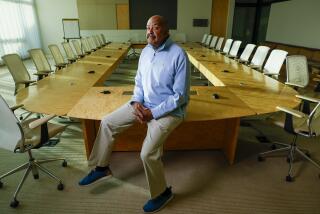It’s a Do-It-Yourself Era for Budding Benefactors
- Share via
Norman Miller’s investment strategy was fittingly modest for a man who has spent more than 50 years tuning pianos: Just set aside a little money on a regular basis and hope for the best.
The strategy worked. Even after the ongoing stock market troubles, Miller’s portfolio is worth nearly $1 million.
“Which was really kind of a surprise,” Miller said. “This isn’t the kind of occupation you make a lot of money in....Fortunately, those [stocks] that we invested in turned out to be mostly pretty good.”
Now comes the fun part: giving it all away.
Three years ago, Miller and his wife, Pauline, both in their 80s, created a nonprofit family foundation in Mission Viejo, joining a national trend that made the 1990s a decade of unprecedented giving.
Two of five foundations with assets of more than $1 million began in the ‘90s, fueled by huge increases in personal wealth and a desire by donors to exert more control over their philanthropy, foundation experts say.
Overall, the number of foundations grew to 56,582 in 2000, up 12.7% from the prior year, the largest single-year increase since 1975, according to estimates released last week by the Foundation Center, a national organization that analyzes foundations.
“The majority of them are small--I would say the majority are under $1 million in assets and are giving less than $100,000 [in grants],” said Loren Renz, vice president for research at the Foundation Center.
That continues a long-running trend in which more than 60% of foundations have assets of less than $1 million, according to the center’s statistics. In 1999, the last year for which such figures have been analyzed, only 48 foundations had assets of more than $1 billion, but were responsible for 24% of grants.
Most of those large foundations were formed two and three generations ago--some dating to the early 20th century--with a few exceptions, such as the Bill and Melinda Gates Foundation, which began in 1995 and holds $24 billion in assets.
Conversely, the 30,791 foundations worth less than $1 million accounted for 7.7% of grants given in 1999.
Yet Renz said the size of the smaller and newer foundations is less significant than what they can do in the future, because many are created by philanthropists who plan to include large bequests in their wills.
“It’s really the potential,” Renz said. “People are forming them when they’re younger ... and, for the most part, are setting them up as multigenerational foundations.”
That’s exactly what the Millers have in mind.
Miller and his wife have long supported humanitarian and environmental causes, including setting up annuities that benefit specific organizations.
Miller said the couple was advised to go one step further and establish the foundation. They also placed their portfolio in a “remainder trust,” which supports them while they are alive and, upon their death, goes to the foundation bearing their names.
In the meantime, Miller said, the couple wanted to ensure their descendants would continue their good works. So they donated about $100,000 to their foundation, appointed two daughters as officers and placed six grandchildren on the board of directors.
In 2000, the Miller Foundation, with assets of about $90,000, gave away $4,175 in mostly $50 and $100 grants to more than 50 groups, including the Southern Poverty Law Center, the American Red Cross and the National Wildlife Federation.
Miller sees those gifts as a practice run for his children and grandchildren.
“Hopefully, when we leave the scene, the foundation will continue and with the objectives we have set,” Miller said. “They will help implement it and keep it going.”
*
Economic Downtown Cuts Value of Portfolios
While the foundering economy of the last two years has eroded the value of the Millers’ portfolio--it was well above $1 million before the downturn--it has also cut into giving by established foundations, the Foundation Center said.
Grants given by foundations grew in 2001 to a record $29 billion, up 5.1%, but that was the smallest annual increase since 1994, it said.
Still, the center saw the increase as unexpected good news against a backdrop of crumbling stock values, belly-up dot-coms and national pessimism over the direction of the economy.
Part of the growth came from multi-year commitments made by large institutions before the recession, and part from a strategy by foundations to invest conservatively, shielding assets from the most volatile market swings.
“They think about giving in terms of how much they need to produce, and in terms of their assets over a period of a few years,” Renz said. “That helps to even it out.”
Jeff Lawrence is learning about those cycles firsthand. Lawrence and his wife, Diane Troth, created the Santa Monica-based Lawrence Foundation two years ago with $12 million, part of the $300 million that Intel paid for their Trillium Digital Systems in August 2000.
Since then, the foundation’s assets have fallen with the rest of the technology market, and the foundation is worth about $5 million now. Lawrence said the sudden depreciation hasn’t lessened the couple’s ambition to aid educational, health and environmental causes.
“We feel it’s important to help other people with their vision and help them succeed,” Lawrence said. He added that developing a foundation brings the same sense of satisfaction that came with developing their business. “Plus, we can influence the direction of our giving more closely.”
Jim Banks and Marie St. Germain stand at the other economic end of the foundation scale.
The couple formed a foundation in 1995 to qualify for tax deductions for the more than $2,000 a year they spent caring for feral cats near their home in Huntington Beach.
Banks, a lawyer, prepared the paperwork, cutting the costs associated with obtaining nonprofit status from the Internal Revenue Service.
For most people, establishing an independent foundation can cost $5,000 to $10,000, depending on the complexity, said Shelley Hoss, president of the Orange County Community Foundation. Annual legal and accounting fees vary.
*
Some Recipients Can’t Even Say, ‘Thank You’
The Feral Felines Feeders Inc. of Huntington Beach began after St. Germain spotted a neighbor tending to a colony of more than 40 cats on vacant land south of downtown Huntington Beach.
St. Germain said she and her husband believe stray cats are neglected by animal control officers.
“People abandon [cats], thinking they can take care of themselves,” she said.
Taking over for the neighbor, who has since moved, St. Germain and her husband began feeding the cats. They also rounded them up for trips to the veterinarian to get spayed, neutered and inoculated, then returned the cats to the colony.
It got expensive. IRS forms the couple filed for Feral Feline Feeders list more than $6,700 in expenses for 1997-2000. That spending pace dropped two years ago after the couple moved the dwindling colony of about 18 cats to Rancho Lotsa Cats Feline Rescue in San Diego’s Valley Center.
Now their donations to Feral Feline Feeders are passed on to the sanctuary. “We feel responsible for them,” St. Germain said about the cats. “We took them down there. A lot of other people do similar things, but lots of people don’t have a way to write off what they spend.”
More to Read
Sign up for Essential California
The most important California stories and recommendations in your inbox every morning.
You may occasionally receive promotional content from the Los Angeles Times.











